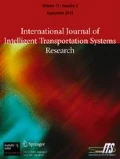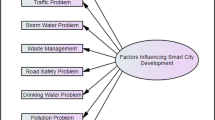Abstract
This study has two objectives. First, this study investigated the barriers and their relationship that make ITS project development in Semarang City still hard. Second, this study aimed to propose some policies to mitigate those barriers. This study identifies 16 ITS project implementation barriers based on the previous research. Then, to fulfill the research objectives, this study employs three distinct methods: content validity analysis as a technique to measuring how well the factors correspond to or reflect a barrier to the ITS project’s implementation; interpretive structural modeling (ISM) as a technique for determining the direct or indirect between barriers; and Delphi as the technique to find the consensus of proposed policies to mitigate the significant barriers. The result of data processing with ISM indicated that internal organizational barriers in the context of the timing of procedure for writing plans, divided responsibilities, and the right organizational system to drive ITS project’s implementation occupied the topmost level. This barrier is affected by the lower level and has less influence than the remaining barriers. The result of data processing with the ISM method also indicated three very significant barriers to the ITS project’s implementation, namely low interoperability of the system at the Department of Transportation Semarang City, which is making it challenging to integrate the ITS-based transportation system; lack of involvement of related institutions to build long-term commitment and awareness that ITS project’s implementation has potential lack of awareness that the ITS project’s implementation has the potential to reduce crashes and save lives; and political problems (political short-termism or discontinuities due to political cycles). Then, the result of data processing with Delphi proposed and validated several policies to mitigate those barriers.



Similar content being viewed by others
References
Purnomo, A., Setiawan, M.F.: The feasibility of BRT corridor VI shelters in Semarang City. In Proceedings of AIP Conference, Semarang, Indonesia (2018)
Rakhmatulloh, A.R., Dewi, D.K., Nugraheni, D.M.K.: Bus Trans Semarang toward sustainable transportation in Semarang City. In Proceedings of The 1st International Conference on Urban Design and Planning, Semarang, Indonesia (2020)
Pujiati, A., Nihayah, D.M., Bowo, P.A., Prastiwi, F.S.: Willingness to pay for improving the quality of public transportation. Jurnal Ekonomi dan Kebijakan (JEJAK) 12(2), 365–381 (2019)
Fafurida, F., Oktavilia, S.: Sustainable transportation strategy in Semarang City, Indonesia. Test Eng. Manag. 83, 16868–16872 (2020)
Singh, G., Bansal, D., danSofat, S.: Intelligent transportation system for developing countries-A survey. Int. J. Comput. Appl. 85(3), 34–38 (2014)
Gifford, J.: Information technology and transportation. Presentation at ITIF Event, Digital Quality of Life: Transportation, (2009)
Zhou, X., Gifford, J.: Institutional challenges in the development of intelligent transportation systems: Route 1 corridor and the national capitol region. In Transportation Research Board 97th Annual Meeting, Washington, DC (2010)
Mandžuka, S.: Intelligent transport systems: selected lecturer. University of Zagreb, Zagreb (2015)
Marchau, V., Wiethoff, M., Penttinen, M., Molin, E.: Stated preferences of European drivers regarding advanced driver assistance systems (ADAS). Eur. J. Transp. Infrastruct. Res. 1(3), 291–308 (2001)
Bakogiannis, E., Kyriakidis, C., Siti, M., Eleftheriou, V.: Four stories for sustainable mobility in Greece. Transportation Research Procedia 24, 345–353 (2017)
Xiong, Z., Sheng, H., Rong, W.G., Cooper, D.E.: Intelligent transportation systems for smart cities: A progress review. SCIENCE CHINA Inf. Sci. 55(12), 2908–2914 (2012)
Grant-Muller, S., Usher, M.: Intelligent transport systems: the propensity for environmental and economic benefits. Technol. Forecast. Soc. Chang. 82, 149–166 (2014)
Sandor, Z., Csiszár, C.: Development stages of intelligent parking information systems for trucks. Acta Polytechnica Hungarica 10(4), 161–174 (2013)
Balasubramaniam, A., Paul, A., Hong, W.H., Seo, H., Kim, J.H.: Comparative analysis of intelligent transportation systems for sustainable environment in smart cities. Sustainability 9(7), 1120–1131 (2017)
Kala, R.: Intelligent transportation systems with diverse vehicles. On-Road Intelligent Vehicles, pp. 420–458. Oxford, Burlington (2016)
Hull, A.D., Tricker, R.C.: Assessing barriers to sustainable UK urban transport solutions. Proc. Inst. Civ. Eng.: Eng. Sustain. 158(3), 171–180 (2005)
Ezell, S.: Explaining international IT application leadership: Intelligent transportation systems. The Information Technology & Innovation Foundation, Washington, DC (2010)
Lindau, L.A., Hidalgo, D., de Almeida Lobo, A.: Barriers to planning and implementing Bus Rapid Transit systems. Res. Transp. Econ. 48, 9–15 (2014)
Kaufman, S.M., Smith, A., O’Connell, J., Marulli, D.: Intelligent paratransit. The Rudin Center for Transportation Policy & Management, New York (2016)
El Mokaddem, Y., Jawab, F., Saad, L.E.: Intelligent transportations systems : review of current challenges and success factors: the case of developing countries. In Proceedings of 12th International Colloquium on Logistics and Supply Chain Management (LOGISTIQUA), Paris (2019)
Figueiredo, L., Jesus, I., Machado, J.A., Ferreira, J.R., Carvalho, M.: Towards the Development of Intelligent Transportations Systems. In Proceedings of IEEE Intelligent Transportation Systems Conference, Oakland (CA) (2001)
Yatskiv, I., Savrasovs, M., Alfimova, K.: Development of intelligent transportation system implementation impact 213 evaluation methodology: case-study of Riga. In Proceedings of The 17 th International conference on Harbor, Maritime & Multimodal Logistics Modelling and Simulatiion, Bordeaux, France (2014)
Miles, J.C., Chen, K.: PIARC ITS Handbook, 2nd edn. Andrew Barriball, UK (2004)
World Bank Report: Dubow, J.: Big data and urban mobility. World Bank, Cairo (2014)
Behruz, H., Chavoshy, A.P., Rad, A.L., Mozaffari, G.: Challenges of implementation of intelligent transportation systems in developing countries: case study–Tehran. WIT Trans. Ecol. Environ. 179, 977–987 (2013)
Karim, Z., Fouad, J.: An analysis of public bus transport performance and its determinants factors: The case of major Morocco's cities. In Proceedings of 2018 International Colloquium on Logistics and Supply Chain Management (LOGISTIQUA), Tangier, Morocco (2018)
Booysen, M.J.: The relevance of intelligent transportation systems in sub-Saharan Africa, p. 20–23. Development Bank of Southern Africa eDijest (2012)
Hidalgo, D., Huizenga, C.: Implementation of sustainable urban transport in Latin America. Res. Transp. Econ. 40(1), 66–77 (2013)
Saffari, E., Golroo, A., Mesbah, M., Ashna, M.: A methodology to develop an ITS architecture for developing countries: Case study of Iran. In Transportation Research Board 97th Annual Meeting, Washington, DC (2018)
El Husseiny, H.M., El Meligy, B., Hassan, M.: The opportunities and challenges of applying intelligent transport systems (ITSS) on road transport in egypt: a case study on cairoalexandria desert road. The Business and Management Review 8(5), 100–110 (2017)
Hsu, I.Y.Y., Wodczak, M., White, R.G., Zhang, T., Hsing, T.R.:Challenges, approaches, and solutions in intelligent transportation systems. In Proceedings of International Conference on Ubiquitous and Future Networks (ICUFN), Jeju (2010)
Sarkar, P.K., Jain, A.K.: Intelligent transport systems. PHI Learning Pvt Ltd, New Delhi (2017)
Zamanzadeh, V., Ghahramanian, A., Rassouli, M., Abbaszadeh, A., Alavi, H.: Design and implementation content validity study: development of an instrument for measuring patient-centered communication. Journal of Caring Science 4(5), 165–178 (2015)
Warfield, J.N.: Developing interconnection matrices in structural modeling, pp. 81–87. IEEE Transactions on Systems, Man, and Cybernetics, Vol. SMC-4 No. 1 (1974)
Sage, A.: Interpretive Structural Modeling: Methodology for Large-Scale Systems. McGraw-Hill, New York (1977)
Mandal, A., Deshmukh, S.G.: Vendor selection using interpretive structural modelling (ISM). Int. J. Oper. Prod. Manag. 14(6), 52–59 (1994)
Singh, M.D., Shankar, R., Narain, R., Agarwal, A.: An interpretive structural modeling of knowledge management in engineering industries. J. Adv. Manag. Res. 1(1), 28–40 (2003)
Ravi, V., Shankar, R., Tiwari, M.K.: Analyzing alternatives in reverse logistics for end-of-life computers: ANP and balanced scorecard approach. Comput. Ind. Eng. 48(2), 327–356 (2005)
Ravi, V., Shankar, R.: Analysis of interactions among the barriers of reverse logistics. Technol. Forecast. Soc. Chang. 72(8), 1011–1029 (2005)
Huang, J.J., Tzeng, G.H., Ong, C.S.: Multidimensional data in multidimensional scaling using the analytic network process. Pattern Recogn. Lett. 26(6), 755–767 (2005)
Kannan, G., Haq, A.N.: Analysis of interactions of criteria and sub-criteria for the selection of supplier in the built-in-order supply chain environment. Int. J. Prod. Res. 45(17), 3831–3852 (2007)
Kannan, G., Haq, A.N., Sasikumar, P., Arunachalam, S.: Analysis and selection of green suppliers using interpretative structural modelling and analytic hierarchy process. Int. J. Manag. Decis. Mak. 9(2), 163–182 (2008)
Kannan, G., Pokharel, S., Kumar, P.S.: A hybrid approach using ISM and fuzzy TOPSIS for the selection of reverse logistics provider. Resour. Conserv. Recycl. 54(1), 28–36 (2009)
Diabat, A., Govindan, K.: An analysis of the drivers affecting the implementation of green supply chain management. Resour. Conserv. Recycl. 55(6), 659–667 (2011)
Talib, F., Rahman, Z., Qureshi, M.N.: An interpretive structural modelling (ISM) approach for modelling the practices of total quality management in service sector. Int. J. Model. Oper. Manag. 1(3), 223–250 (2011)
Mathiyazhagan, K., Govindan, K., NoorulHaq, A., Geng, Y.: An ISM approach for the barrier analysis in implementing green supply chain management. J. Clean. Prod. 47, 283–297 (2013)
Abdullah, M.R.T.L., Al-Amin, M.N., Ur-Rahman, A., Baharuddin, A., Ahmad, Z.: Sustainable socio-religious harmony development in Malaysia: an interpretive structural modelling for multi-religious society. J. Al-Tamaddun 12(1), 53–64 (2017)
Susanty, A., Puspitasari, N.B., Purwaningsih, R., Siregar, A.R.R.: Measuring the sustainability of the broiler chicken supply chain. International Journal of Agile Systems and Management (2021) forthcoming articles, https://www.inderscience.com/info/ingeneral/forthcoming.php?jcode=ijasm
Qureshi, M.N., Kumar, D., Kumar, P.: Modeling the logistics outsourcing relationship variables to enhance shippers’ productivity and competitiveness in logistical supply chain. Int. J. Product. Perform. Manag. 56(8), 689–714 (2007)
Chauhan, A., Debnath, R.M., Singh, S.P.: Modelling the drivers for sustainable Agri-food waste management. BIJ 25(3), 981–993 (2018)
Linstone, H.A., Turoff, M.: “Introduction”, The Delphi Method: Techniques and applications. Addison-Wesley Publishing Company, Boston (1975)
Habibi, A., Sarafrazi, A., Izadyar, S.: Delphi technique theoretical framework in qualitative research. Int. J. Eng. Sci. 3(4), 8–13 (2014)
Adler, M., Ziglio, E.: Gazing into the oracle: The Delphi method and its application to social policy and public health. Jessica Kingsley Publishers (1996)
Malone, D.W.: An introduction to the application of interpretive structural modeling. Proc. IEEE 63(3), 397–404 (1975)
Watson, R.H.: Interpretive structural modeling-A useful tool for technology assessment? Technol. Forecast. Soc. Chang. 11(2), 165–185 (1978)
Broome, B.J., DeTurk, S., Kristjansdottir, E.S., Kanata, T., Ganesan, P.: Giving voice to diversity: An interactive approach to conflict management and decision-making in culturally diverse work environments. J. Bus. Manag. 8(3), 239–264 (2002)
Sushil: “Interpreting the interpretive structural model. Glob. J. Flex. Syst. Manag. 13(2), 87–106 (2012)
Acknowledgements
The authors would like to thank Dean of Faculty of Engineering, Diponegoro University, Semarang for funding this research under the “Peneltian Strategis” grant.
Author information
Authors and Affiliations
Corresponding author
Ethics declarations
Conflict of Interest
The authors declare that they have no conflict of interest.
Additional information
Publisher's Note
Springer Nature remains neutral with regard to jurisdictional claims in published maps and institutional affiliations.
Rights and permissions
About this article
Cite this article
Susanty, A., Putri, V.A. & Purwanggono, B. Proposed Policy to Manage the Barrier of the Implementation of Intelligent Transportation System. Int. J. ITS Res. 20, 540–559 (2022). https://doi.org/10.1007/s13177-022-00310-8
Received:
Revised:
Accepted:
Published:
Issue Date:
DOI: https://doi.org/10.1007/s13177-022-00310-8




